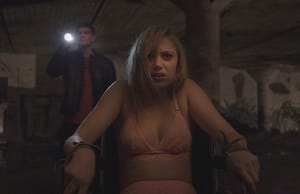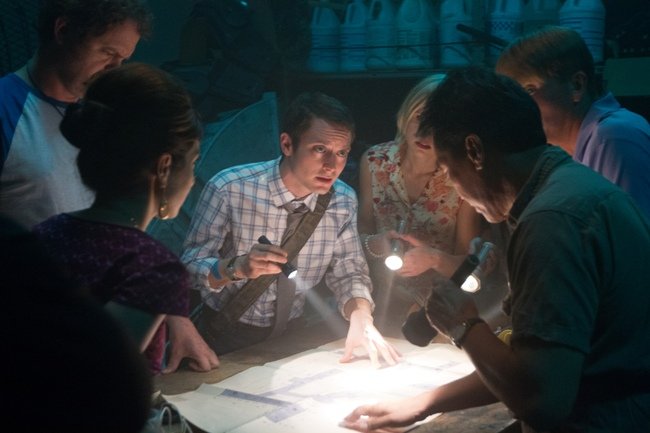
World-Building as Business Model
Having weighed the options for your indie horror’s mid-release strategy, then, a burning question remains: How can my film go viral? Does a cultural phenomenon like The Blair Witch Project just “happen,” or can a frenzied demand for your film be, to some extent, orchestrated?
The “never-ending, wrap-around, elliptical origins story” of the malignant “It’ in It Follows—that is, a sexually-transmitted supernatural entity—is a creative and in-built marketing element. Quinn says that element gave him the inkling of wide-release potential from day one, when RADiUS purchased the film at Cannes in 2014. The mythos surrounding The Blair Witch Project’s titular witch; in Paranormal Activity, the mythos of the demonic entity that stalks, possesses, and murders several members of one family—these origin stories are what those hits have in common with It Follows.
Eduardo Sánchez and co-writer/co-director Daniel Myrick made Blair Witch for roughly $22,500, and, working closely with their distributor, Artisan Entertainment, created a game-changing website, blairwitch.com, which propagated the marketing-savvy myth that the film’s origins story was based on true events. Paranormal Activity, made for $15,000, was released by Paramount in 13 U.S. college towns, and writer-director Oren Peli invited audiences to “demand” where the film would screen next by voting on the online calendar and events discovery service Eventful. Both films made viral marketing history with their respective uses of websites and event-search services; whereas The Blair Witch Project’s inevitable expansion to a wide release grossed $248,639,099 worldwide, Paranormal Activity’s grossed $193,355,800.
Your indie horror’s creative premise and marketing potential will inform its releasing criteria. “If you can articulate your vision, that helps us articulate a strong distribution strategy for the picture,” says Gordon. “It’s all about communication.”
The marketable afterlife of a feature with franchising prospects (like Sánchez and Myrick’s film, which spawned a sequel, and Peli’s, which spawned five), Ward says, can even be discussed “during” RLJ’s acquisitions process. He points to Bobby Roe’s The Houses That October Built and Adam Green’s Digging Up the Marrow as examples that “clearly have sequels in mind. At that point, in comes down to economics.”
“Creating your own franchise,” he says, “is harder these days when we’re not going on 4,000 screens, but it’s good for business, and the fans wanna stay in a world.” When speaking with a distributor, foresee and communicate to that company the prospect of producing future content as offshoots of your first film. Though nothing is set in stone, the possibility of their creation may increase the likelihood that your distributor takes a gamble on a bigger release for your indie.
Gordon brings up XLrator’s latest example of world-building integrating with multiplatform potential: Keith Arem’s based-on-a-real-event feature The Phoenix Incident, about a possible alien encounter over Phoenix, Arizona. Arem debuted supposedly classified footage at Comic-Con this year. Says Gordon: “That has multiplatform capabilities—into the gaming community; into the computer science and tech world.” If a viewer wanted to learn more about the history, he suggests, that information would be available in an app. “Those are new palettes that some filmmakers—not all—are gonna want to play with going into the future.”

Elijah Wood (center) produced and stars in SpectreVision’s Cooties, which Lionsgate released in theaters in September 2015
Exploit the Future
“Fear of the unknown”—that time-old cliché of horror—could describe the anxiety with which distributors stare down the 25-and-under demographic that most readily and often consumes frightening fare. The Blair Witch Project, Paranormal Activity, It Follows, I-Lived, and Burying the Ex both cater to and depict this crowd, which Quinn says he’s been trying to understand for over a decade. “10 years ago, at Film Society of Lincoln Center or any of the commercial theaters uptown, you’d never see an under-25 audience. You go out there now, it’s like, ‘Wait a minute—where did all these people come from?’
“There’s a younger generation of film-lovers out there that can go out and see a movie that grosses $1-4 million, which are the ‘singles and doubles’ that make up a traditional distributor like Sony Classics,” he says. “There’s not an aversion to violence. Kids are more adventurous and global.”
Keep the faith in the desire among young adults to see films in a traditional, communal setting. But remember, too, that young audiences are “actually watching more content,” says Quinn. “How they watch it should be at their discretion, and not necessarily in some forced distribution strategy or platforms. Viewing habits have changed.”
Nothing is certain—though focusing on the “exploitable elements” of genre, as Wood puts it, is always a good bet. Armed with an increasing set of knowns to navigate the guaranteed unknowns of the horror marketplace, independents can begin their push toward mobilizing audiences, maximizing profits, and minimizing the dangers of releasing their (evil) babies out into the world. MM
This article appeared in MovieMaker‘s Fall 2015 issue.
Share:

